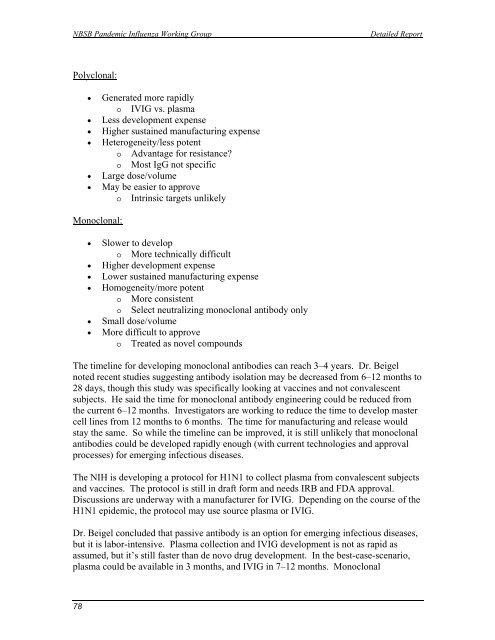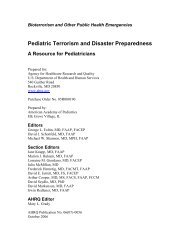H1N1 COUNTERMEASURES STRATEGY AND ... - PHE Home
H1N1 COUNTERMEASURES STRATEGY AND ... - PHE Home
H1N1 COUNTERMEASURES STRATEGY AND ... - PHE Home
You also want an ePaper? Increase the reach of your titles
YUMPU automatically turns print PDFs into web optimized ePapers that Google loves.
NBSB Pandemic Influenza Working Group<br />
Detailed Report<br />
Polyclonal:<br />
<br />
<br />
<br />
<br />
<br />
<br />
Generated more rapidly<br />
o IVIG vs. plasma <br />
Less development expense <br />
Higher sustained manufacturing expense <br />
Heterogeneity/less potent <br />
o Advantage for resistance?<br />
o Most IgG not specific <br />
Large dose/volume <br />
May be easier to approve <br />
o Intrinsic targets unlikely<br />
Monoclonal:<br />
<br />
<br />
<br />
<br />
<br />
<br />
Slower to develop<br />
o More technically difficult <br />
Higher development expense <br />
Lower sustained manufacturing expense <br />
Homogeneity/more potent <br />
o More consistent<br />
o Select neutralizing monoclonal antibody only <br />
Small dose/volume <br />
More difficult to approve <br />
o Treated as novel compounds<br />
The timeline for developing monoclonal antibodies can reach 3–4 years. Dr. Beigel<br />
noted recent studies suggesting antibody isolation may be decreased from 6–12 months to<br />
28 days, though this study was specifically looking at vaccines and not convalescent<br />
subjects. He said the time for monoclonal antibody engineering could be reduced from<br />
the current 6–12 months. Investigators are working to reduce the time to develop master<br />
cell lines from 12 months to 6 months. The time for manufacturing and release would<br />
stay the same. So while the timeline can be improved, it is still unlikely that monoclonal<br />
antibodies could be developed rapidly enough (with current technologies and approval<br />
processes) for emerging infectious diseases.<br />
The NIH is developing a protocol for <strong>H1N1</strong> to collect plasma from convalescent subjects<br />
and vaccines. The protocol is still in draft form and needs IRB and FDA approval.<br />
Discussions are underway with a manufacturer for IVIG. Depending on the course of the<br />
<strong>H1N1</strong> epidemic, the protocol may use source plasma or IVIG.<br />
Dr. Beigel concluded that passive antibody is an option for emerging infectious diseases,<br />
but it is labor-intensive. Plasma collection and IVIG development is not as rapid as<br />
assumed, but it’s still faster than de novo drug development. In the best-case-scenario,<br />
plasma could be available in 3 months, and IVIG in 7–12 months. Monoclonal<br />
78
















